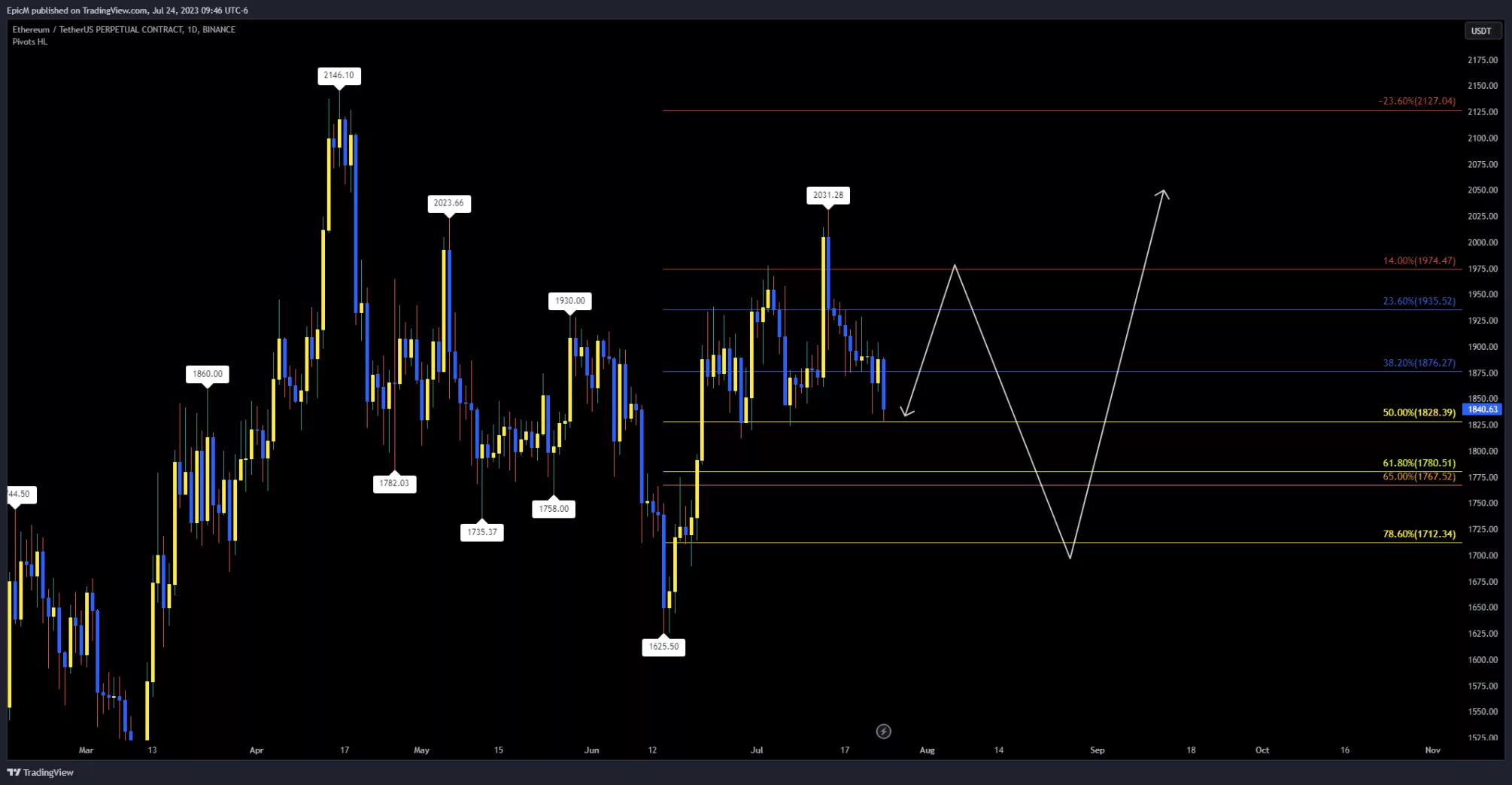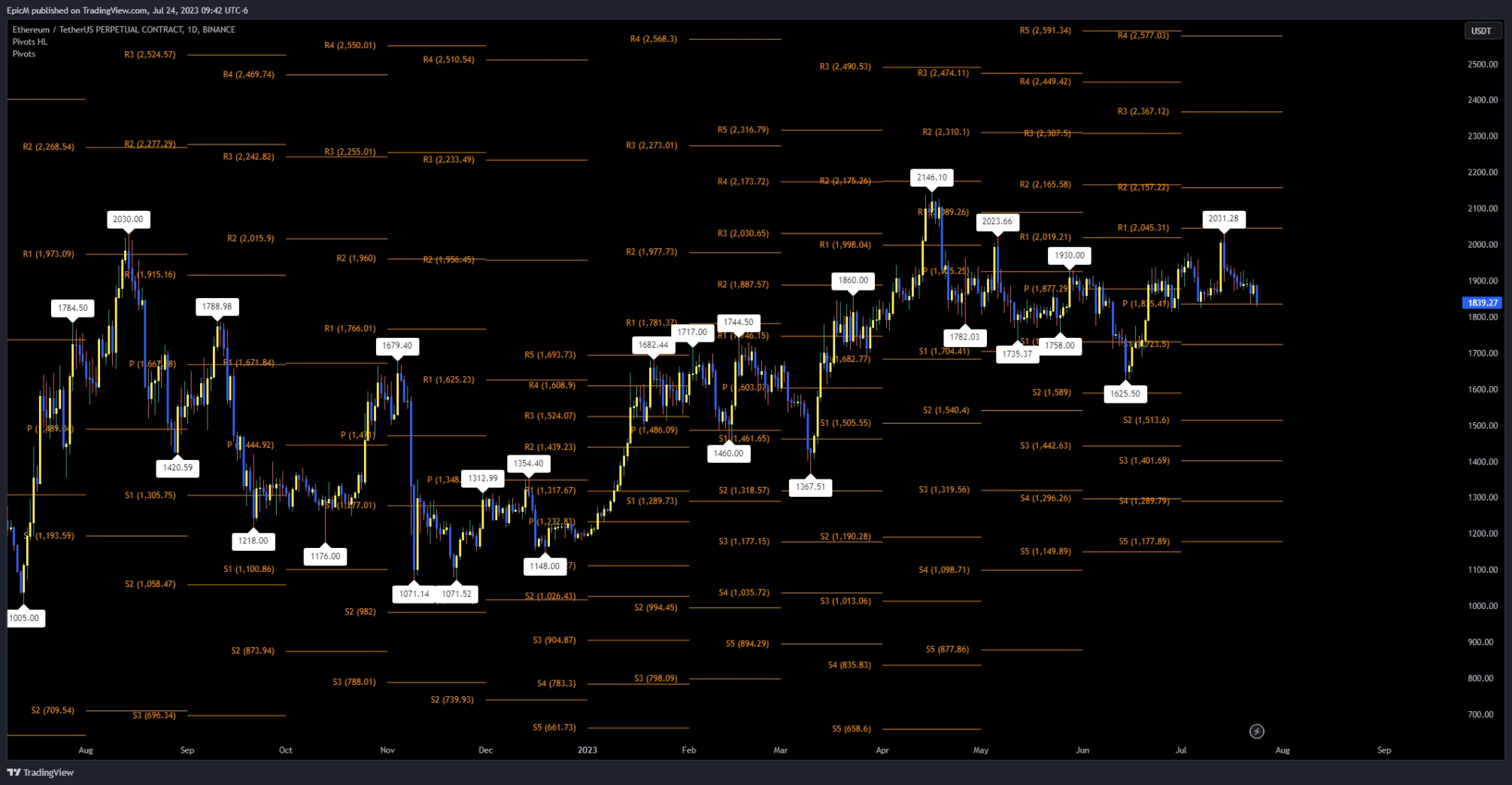In the fast-paced and ever-evolving world of intraday trading, inertia is the equivalent to regression. This high-pressure setting requires grappling with fleeting time and unstable market circumstances where every tick of the clock matters. Within such an intense environment, pivot points serve as your trusted compass, aiding you to traverse the complicated and detailed universe of financial markets securely. They are not just mathematical computations; they hold a crucial role in decision-making which can significantly impact the results of your trades.
This article will help you decipher which pivot points are best for intraday trading an essential skill in a trader’s arsenal. You’ll learn how to calculate them precisely, strategies for using them effectively under different market scenarios, and tips on selecting the most suitable pivot point indicators for your needs.
So strap in as we embark on this journey to master one of the most powerful tools available for intraday traders.
Key Takeaways
- Pivot point breakouts and pivot point bounces are both effective strategies for intraday trading.
- Daily pivot level breakout strategy can significantly improve trading performance by using pivot points to determine entry, stop loss, and take profit levels.
- The choice of a suitable pivot point indicator should consider factors such as market volatility, time frame, and trading strategy.
- Standard pivot points are best for highly volatile markets, Fibonacci pivots work well during major price swings, and Camarilla pivots are effective in highly liquid markets.
Understanding the Role of Pivot Points in Intraday Trading

As an intraday trader, understanding the role of pivot points is vital to my success in predicting potential market movements. I’ve found that recognizing these pivot points as support and resistance levels can impact the outcomes of my trades.
The challenge lies in differentiating between Standard, Fibonacci, and Camarilla Pivot Points. Each type offers unique insights into market trends and opportunities.
Recognizing the Purpose of Pivot Points as Support and Resistance Levels
Picture pivot points as your trusty road signs on the hectic highway of intraday trading. They guide you by functioning at potential support and resistance levels. This concept is integral to mastering pivot point trading.
The support level shows when it’s best for intraday buying. Recognizing pivot points as support and resistance levels offers invaluable insights into market dynamics.
Let’s now delve into the nuances between standard Fibonacci and Camarilla pivot points.
Differentiating Between Standard, Fibonacci and Camarilla Pivot Points
You may feel overwhelmed by the myriad of technical analysis tools out there, but don’t let that deter you from understanding the differences between standard Fibonacci and Camarilla methods.
Standard pivot points are best for intraday trading based on daily data.
However, if you’re seeking more dynamic levels, try using Fibonacci or Camarilla pivot points.
Mastering different pivot points can pave your way to predict potential market movements effectively.
How Pivot Points Help Traders Identify Potential Market Movements
Believe it or not, nearly 95% of traders use technical analysis tools like pivot points to spot potential market movements and make informed trading decisions. Their importance in intraday trading can’t be overstated.
Pivot points are best for intraday because they provide real-time support and resistance levels. They help traders identify potential market movements by highlighting price trends. Using pivot point strategies can lead to improved decision making. They help identify optimal entry and exit points.
This brings us to why every intraday trader should use pivot points.
Why Intraday Traders Should Use Pivot Points

As an intraday trader, I appreciate the critical role pivot points play in identifying potential trading opportunities. They not only provide me with key price levels where significant buying or selling activity might occur, but also facilitate risk management by offering a clear framework for setting stop loss and take profit levels.
In fact, these pivot points have become indispensable in building my effective trading strategies. They help me navigate the unpredictable waters of day trading with much more confidence and precision.
The Critical Role of Pivot Points in Identifying Trading Opportunities
Pivot points aren’t just fancy trading jargon; they’re crucial for spotting lucrative intraday opportunities. Recognizing their critical role in identifying trading opportunities, I’d argue pivot points are best for intraday trading because of their ability to define market trends, highlight key resistance and support levels, suggest potential reversal zones, and act as the best pivot point indicator. Pivot points give simple entry and exit signals.
By mastering these concepts, not only will you spot opportunities but also better manage risks in your next trades.
How Pivot Points Facilitate Risk Management for Day Traders
Imagine the confidence you’d feel, stepping into each trading day armed with a powerful tool that not only highlights golden opportunities but also actively helps you sidestep potential pitfalls. That’s what pivot points offer, especially for intraday trading.
By employing daily pivot points in my pivot point trading strategies, I effectively handle risk management for day traders.
Now let’s delve deeper into how these pivotal indicators function in building effective trading strategies.
The Function of Pivot Points in Building Effective Trading Strategies
You’re probably wondering how these pivotal indicators function in crafting effective trading strategies, right? Well:
- Pivot points are best for intraday trading because of their predictive power.
- They help in building trading strategies around price trends.
- The function of pivot points is to provide key support and resistance levels.
- They aid in identifying potential entry and exit points.
- Using pivot points can increase the effectiveness of risk management.
Now, let’s delve into learning to precisely calculate pivot point levels.
Learning to Precisely Calculate Pivot Point Levels
As we delve deeper into the world of pivot points, let’s inspect how to precisely calculate them.
We’ll start with a step-by-step guide to computing standard pivot points before mastering the calculation of Fibonacci pivot points.
After that, we’ll dive deep into calculating Camarilla pivot points to provide you with an extensive understanding of this powerful tool in intraday trading.
Step-by-Step Guide to Calculating Standard Pivot Points
Ever wondered how to calculate standard pivot points for your intraday trading strategies? Here’s a step-by-step guide:
- Start by identifying the high, low, and closing prices from the previous trading day.
- Use these prices in the basic pivot level part of the pivot points formula to calculate the pivot.
Mastering this technique will equip you with an essential tool for precise intraday trading.
Now, let’s delve into calculating Fibonacci pivot points next.
Mastering the Calculation of Fibonacci Pivot Points
Ready to dive deeper into your trading strategy toolkit? Let’s master the art of calculating Fibonacci pivot points. They’re a technical analysis tool that I find are best for intraday trading. Here’s a table to visualize:
| Previous Day’s High | Previous Day’s Low |
|---|---|
| Use these values | In your calculation |
After mastering this, you’ll be ready for the next level – getting to grips with Camarilla pivot points.
A Deep-Dive into Calculating Camarilla Pivot Points
Having mastered Fibonacci pivot points, let’s now dive into another effective tool for intraday trading – Camarilla pivot points.
Calculating Camarilla pivot points can be a game-changer in your trading approach. They’re widely accepted as one of the pivot points that are best for intraday because of their accuracy in identifying key market levels.
Now that we’re familiar with this, let’s transition into its practical application in real-time intraday market scenarios.
How to Trade Using Pivot Points in Intraday Market Scenarios

As we dive deeper into the world of intraday trading, I want to share with you some strategies on how we can leverage pivot points to maximize our profits.
First, let’s discuss strategizing trades based on pivot point breakouts. When the price breaks above the pivot point level, it shows a bullish sentiment, and we can consider entering a long position. Conversely, if the price breaks below the pivot point level, it shows a bearish sentiment, and we can consider entering a short position. It’s important to wait for a confirmed breakout before entering a trade.
Next, let’s talk about navigating trades with the help of pivot point bounces. If the price bounces off the pivot point level, it suggests a potential reversal in the market. We can look for opportunities to enter a trade in the opposite direction of the bounce. For example, if the price bounces off the pivot point level and starts moving upward, we can consider entering a long position.
Last, let’s explore profiting from the daily pivot level breakout strategy. This strategy involves monitoring the daily pivot level and waiting for a breakout above or below it. If the price breaks above the daily pivot level, it suggests a bullish sentiment, and we can consider entering a long position. If the price breaks below the daily pivot level, it suggests a bearish sentiment, and we can consider entering a short position.
It proved these methods that have helped me succeed in various market scenarios, and I believe they can work for you, too. Remember to always analyze the market conditions and use proper risk management techniques when trading with pivot points.
Strategizing Trades Based on Pivot Point Breakouts
Interestingly, about 70% of day traders use pivot point breakouts in their strategy to maximize profits and minimize losses. Strategizing trades based on these breakouts can be an effective method for intraday trading.
The pivot points are best used within a comprehensive pivot point system, allowing me to time my entries and exits accurately.
Now let’s delve into another key aspect – navigating trades with the help of pivot point bounces.
Navigating Trades with the Help of Pivot Point Bounces
Understanding how to navigate trades using pivot point bounces can significantly enhance your trading strategy. Intraday trading is all about agility, and pivot points are useful for intraday trading as they provide critical signals of market movements.
As prices get closer to the pivot point, it is important to watch for a bounce and pivot, as this can signal potential opportunities. This means that when the price reaches the pivot point, it may bounce off and change direction.
Now, let’s delve into profiting from the daily pivot level breakout strategy.
Profiting from the Daily Pivot Level Breakout Strategy
Let’s dive right into the exciting world of profiting from the daily pivot level breakout strategy, a tactic that can truly elevate your trading game. This approach to intraday trading uses pivot points that are best for intraday to determine potential price movements.
| Entry | Stop Loss | Take Profit |
|---|---|---|
| Pivot Breakout | Previous Pivot | Next Pivot |
| Reversal at Support | Below Support Level | Previous Pivot |
| Reversal at Resistance | Above Resistance Level | Previous Pivot |
Mastering this pivot trading technique paves the path towards selecting the most suitable pivot point indicator for your intraday trading.
Selecting the Most Suitable Pivot Point Indicator for Your Intraday Trading

Choosing the right pivot point indicator for your intraday trading can seem daunting, but by considering a few key factors, we can make informed decisions.
We’ll be discussing what influences our choice of a suitable pivot point, when to use standard, Fibonacci or Camarilla pivots, and how to ensure we choose the best pivot point that aligns with our trading goals.
This way, we’re not just picking indicators at random but deliberately selecting tools that elevate our trading game.
Factors Influencing Your Choice of a Suitable Pivot Point
Navigating the stormy seas of intraday trading, several key factors largely influenced your choice of a suitable pivot point. These factors include market volatility, time frame, and your trading strategy.
Market volatility plays a significant role in determining the type of pivot point you should use. In highly volatile markets, standard pivot points may be more appropriate, as they are based on the previous day’s price action. In less volatile markets, fibonacci or camarilla pivots, which consider a wider range of price levels, may be more suitable.
The time frame you are trading on also affects your choice of pivot point. If you are trading on a shorter time frame, such as a 5-minute chart, use camarilla pivots, as they provide more levels of support and resistance. However, if you are trading on a longer time frame, such as a daily chart, standard or fibonacci pivots may be more appropriate.
Your trading strategy is another important factor to consider when choosing a pivot point. If your strategy relies heavily on support and resistance levels, camarilla pivots, which provide more of these levels, may be the best choice. However, if your strategy focuses more on price patterns or trend analysis, standard or fibonacci pivots may be more suitable.
It is important to remember that there is no single type of pivot point that is best for intraday trading in all situations. Your success lies in understanding these factors and using the pivot point that aligns with them.
Now let’s delve into when to use standard, fibonacci, or camarilla pivots.
When to Use Standard, Fibonacci, or Camarilla Pivots
As you sail the tumultuous waves of day trading, knowing when to use standard, fibonacci, or camarilla pivots can be your guiding star to successfully navigate through.
Standard pivot points are best for intraday when market volatility is predictable.
Fibonacci pivots shine during major price swings, while Camarilla pivots work well in highly liquid markets.
Let’s now glide towards ensuring your chosen pivot point aligns with your trading goals.
Ensuring You Choose the Best Pivot Point That Aligns with Your Trading Goals
To ensure your trading strategy sails smoothly, it’s crucial to align the preferred pivot method with your unique goals. Choosing the best pivot point that aligns with your trading goals isn’t just savvy—it’s essential for intraday trading success.
A primary pivot point is a technical analysis milestone; it should resonate like a symphony in your ears.
Ignoring this can lead to emotional turmoil and financial turbulence.
Ensuring you choose the best pivot point is not only smart but also empowering.
Frequently Asked Questions
What are some common mistakes traders make when using pivot points in intraday trading?
One common mistake I’ve seen is not considering the broader market trend. Traders may also inaccurately calculate pivot points or over-rely on them, forgetting they’re just one part of a comprehensive trading strategy.
How can pivot points be used with other trading strategies for intraday trading?
Pivot points can perfectly pair with other strategies, like the moving average or RSI. By blending these tools, you can bolster your buy/sell decisions and better balance risk-reward ratios in intraday trading.
Are pivot points applicable in many market conditions, such as volatile or stable markets?
Absolutely, pivot points apply in all market conditions. They’re versatile and can provide key support and resistance levels in both volatile and stable markets, enhancing your decision-making process during intraday trading.
How do pivot points compare to other technical analysis tools for intraday trading?
“Pivot points blow other technical analysis tools out of the water for intraday trading! They’re like a secret weapon, allowing us to expect market movements with uncanny accuracy. No other tool matches their predictive powers.”
Can pivot points be used for long-term trading strategies, or are they strictly for intraday trading?
Pivot points can indeed be used for long-term trading strategies, not strictly for intraday. They’re versatile tools that adapt to various time frames, aiding in identifying potential support and resistance levels.
Conclusion
Have you decided which pivot points are best for your intraday trading? Understanding and accurately calculating these pivot points can be a game changer. Choose your indicators wisely and let them guide your trades. After all, it’s about making the most of each trading day.
Remember, understanding and accurately calculating these pivot points can be a game changer. Choose your indicators wisely and let them guide your trades. After all, it’s about making the most of each trading day.



